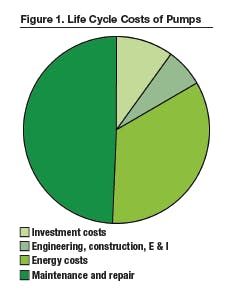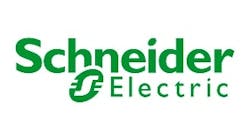Jack Creamer is market segment manager, pumping equipment, for Schneider Electric Industry Business. Creamer can be reached at [email protected]. Grant Van Hemert is water and wastewater applications specialist, Water Wastewater Competency Center, for Schneider Electric. Van Hemert can be reached at [email protected].
Pumps have outgrown their role as simple mechanical workhorses. With the inclusion of “computing capability,” they now can manage both energy consumption and processes alike. With embedded intelligence, they also become a great tool to monitor and implement maintenance programs—reactive, proactive and preventative.
The energy management aspect may be more widely understood today, simply because of the visibility of energy expenses, the clear opportunity to reduce consumption around key applications (e.g., pumping) and the increasing need on the part of the water industry to better manage operating budgets in response to budgetary constraints.
Let’s take a look at both clean water and wastewater systems. On the clean water side, energy accounts for 34% of the operating budget and pumping accounts for more than 85% of the energy consumed. On the wastewater side, energy accounts for 28% of the operation and maintenance budget and pumping contributes almost 20% of the energy consumed.
A Systematic Approach
By taking a systematic approach to energy management, significant gains can be made to reduce energy costs. The first step includes an energy audit, followed by installation of energy measurement systems to target key consumption areas. The next step is to take advantage of “passive” energy-efficiency opportunities that reduce energy consumption in normal operation (e.g., energy-efficient lighting and high-efficiency motors). This process is illustrated in Figure 2.
Then we move to the “active” energy-efficiency mode, where intelligent pumping comes into play. Intelligent pumping is defined by ARC as the combination of a pump and a variable-frequency drive (VFD) with digital control capability. Based on the typical pump life-cycle cost profile, energy costs account for nearly 40% of the total. Combined with maintenance and repair, those costs can escalate to more than 80%. Figure 1 shows a breakdown of a pump’s life cycle costs.
VFDs offer several benefits in pumping system applications:
- If the pump is variable pressure and/or flow, a VFD can provide more enhanced energy savings than mechanical means and potentially reduce total system costs.
- If the pump is a constant-speed pump that is oversized and/or poorly matched to the best efficiency point, reducing the pump speed can correct for either situation.
- If the application is variable loading and has an oversized motor, the VFD can solve both challenges simultaneously.
The potential to reduce the speed of the pump system to match the required load provides an outstanding opportunity to reduce energy consumption. Pumping is a broad field with a variety of technologies. Positive-displacement pumps, centrifugal pumps and jack pumps perform differently, thus the effect of changing speed is different. Because most pumps are centrifugal, however, we can examine this application to illustrate the possibilities.
Centrifugal pumps utilize something called the Affinity Laws.
The Affinity Laws of centrifugal loads state that:
- Flow is proportional to motor speed;
- Pressure is proportional to the motor speed squared; and
- Power is proportional to the motor speed cubed.
For a modest reduction in speed of 10%, the expected reduction in energy consumption is in excess of 25%.
There are some additional benefits to the application of VFDs in pumping systems that should be mentioned:
- They reduce mechanical stress on the pumps and pump systems; resulting in longer life and reduced downtime/reliability issues.
- Less maintenance is required on the pump systems (e.g., valves and inlet guide vanes); and
- Reduced inrush currents lower overall demand and reduce the likelihood of incurring peak power demand charges.
Once these measures are implemented, the next step is to monitor, maintain and improve the system in order to ensure maximum energy savings over time.
Maintenance of Pumps
Let’s take a look at the maintenance side of the equation. Most installed pump systems provide rudimentary data (e.g., running status) and not ready status of the control circuit. While this method has served well for decades, it presents challenges. First, monitoring the contact of a starter does not detect if the wires have become disconnected or if the linkage between the pump and motor is intact. Likewise, the not-ready status will indicate if an electrical problem is present; it will not identify what the problem is or how it occurred.
These limitations can be quite costly. In 1997, Kellogg Brown & Root (now known as KBR Inc.) stated that 85% of troubleshooting time is spent on dead ends. If the time spent on dead ends is minimized, then the task is minimized.
So how much does maintenance cost? The true cost of maintenance includes labor, costs, fines, remediation and impact on perception. Figure 3 (see page 8) shows a graph Meta Group released in October 2000 that identifies maintenance costs by industry. If the pumping system is in energy, then the cost can be $3 million for each hour of maintenance. If the pump is in water and wastewater, the cost is about $750,000 per hour.
Now that we have an idea of the true cost, the next step is to determine the main causes of outages. While a complete discussion of all the causes is beyond the scope of this article, we can look at the motor to get an idea.
Figure 4 (see page 8) shows data from Cooper Bussmann that reflects the causes of motor failures. It indicates that voltage conditions and overloads (which are related to torque) can detect 44% of failures. Rotor failures, bearing failures, contaminants and some of the miscellaneous failures also can impact torque. Likewise, pump failures can impact torque. Torque changes will be reflected in current or power draw. Monitoring power, current and, if possible, voltage can detect 81% to 90% of motor failures, plus some pump failures.
As stated previously, reduction in troubleshooting can have an impact on maintenance costs. This comes as welcome news to cash-strapped small pump systems that may not have dedicated electrical staff to diagnose anomalies.
Data Enhancement
So, what technologies are available for today’s pump control system that can enhance the available data?
One we already touched on is the VFD. Today’s drives analyze performance and create a collection of parameters that can be used to monitor the motor. For instance, Schneider Electric’s ATV 61 has 858 parameters. Some of these parameters (e.g., voltage, current, power, current at last fault, power at last fault, voltage at last fault and torque) are relevant to pumping. Other parameters are more suited for other markets.
Another area where one can collect data is on constant-speed motors. New motor management systems, such as Schneider Electric’s TeSys T, perform data analysis and the function of an overload relay. They can be used where standard eutectic, bimetallic or solid-state devices are used.
A motor management device will measure current and other factors. Like the VFD, these factors will be converted to parameters that can be monitored. The TeSys T unit has 53 parameters in the base unit and an additional 19 parameters in the expansion unit. This expansion unit provides voltage measurement and combines voltage with current to provide power measurement.
As we progress through the 21st century, pumping will need to be more efficient in order to make the most of energy. This can be done by directly utilizing energy-saving techniques and by saving resources through enhanced maintenance.
How Information Saves Maintenance Costs
Scenario: A motor has registered a not-ready signal.
Case No. 1
Steps: A truck heads to the pump station. A reset is engaged, but it does not work. The motor circuit breaker is repeatedly re-engaged and trips immediately. This breaking is too rapid to be seen on the instantaneous meter, so a trip is made back to the shop for a meter with minimum and maximum capability. Once connected, the maximum reading is found to be too fast for the meter to detect.
The next check is to remove the pump from the motor. This is done, but the problem still exists. The starter is examined and appears to be fine. The wires to the motor are tested for conductance and insulation between phases. These are normal. Then, the wiring inside the pump is examined and bad windings are found. The service truck does not have a motor, so another round trip is needed.
Once obtained, a new motor is placed into service. Upon startup, a larger-than-expected amp draw is noticed. Further testing also uncovered bad pump bearings. This required a final round trip to get a set of bearings.
Result: The issue required 10 hours of troubleshooting, including reset and drive time. In the case of a wastewater utility, this resulted in $7.5 million of maintenance time.
Case No. 2
Steps: A truck heads to the pump station, and a browser is connected to the pump panels. A high-voltage spike is recorded in the fault record and a slight but continuously high amp reading is noted. Suspicion arises that the insulation in the motor and possibly the pump bearing are bad. A new motor, bearings and proper meters are placed in a truck. The motor and pump are tested. As suspected, shorted wiring and bad bearings are discovered. Thus, a new motor is installed and the bearings of the pump are replaced.
Result: Troubleshooting takes three hours at a cost of $2.25 million.
Download: Here


